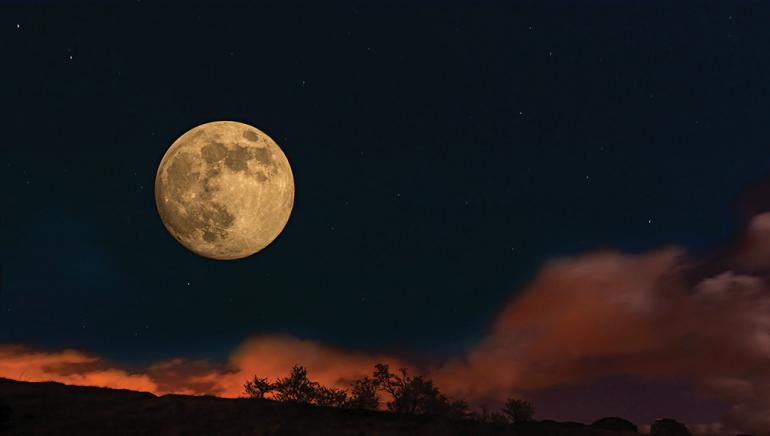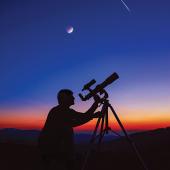Fierce Creatures in the Sky
A lunar eclipse on a flowery spring night.
Spring brings fierce creatures to prominence in the evening sky—as Dorothy in Oz might say, “Lions and tigers and bears, oh my!” For our sake, subtract the tigers.
Go out on an evening in the middle of spring when it gets dark and you can see the Big Dipper—the back and tail of Ursa Major, the Great Bear—swinging just north of overhead. Turn around and you can see the backward question mark and triangle of stars that outline the body of Leo the lion riding a little south of overhead. And each has a sidekick: Ursa Minor, the smaller bear, in the pattern of the Little Dipper with its tail nailed firmly to the North Star, and Leo Minor, a cub lounging rather anonymously among faint stars just above Leo.
Follow the arc of the curved Big Dipper handle to the bright-orange star Arcturus, which sits at the bottom of a large kite-shape of stars, and you’ll have found Bootes the herdsman, trying to keep order as he follows behind.
But this spring, there’s another fierce creature, and a sneakier one, that will show up in the wee hours of May 26 to assail the moon and create a brief, if dramatic, total lunar eclipse. It’s the night of the Flower Moon, the full moon of May—which this year is also a “supermoon” in that it lies very near to perigee, its closest to Earth, and thus appears a bit bigger and brighter than usual. It’s not something you’ll notice particularly, but the evening of the 25th is the time to enjoy the supermoon aspect—for after midnight, the moon goes decidedly dim.
The moon will be southward, lodged in the claws of Scorpius the scorpion; the bright reddish star to the moon’s left is Antares, the scorpion’s beating heart. About a quarter to three on the morning of May 26, that big, flowery moon will start to creep into the faint, outer part of the Earth’s shadow in space, called the penumbra. You won’t notice. But around 3:45 am, the moon runs into the dark inner shadow called the umbra, and that you willsee as the shadow starts nibbling away at the moon.
You’ll need a low southwestern horizon and a clear sky to watch events unfold, for the action happens just as the moon gets ready to set. It crawls deeper into the shadow as morning twilight arrives, and slips completely into the umbra to become totally eclipsed at 5:11 am—but only stays there for about 15 minutes. Since the moon is barely within the umbra, it will remain rather bright along its upper edge; it will look like the Man-in-the-Moon is wearing a beanie on his head. The middle and bottom of the moon should look progressively redder and darker the deeper it lies in the umbra in the brightening sky.
And perhaps here’s where the tiger shows up, for various cultures attributed lunar eclipses to the gory attacks of sneaky, fierce creatures. The Chinese blamed a celestial dragon; cultures of India, a serpent. The Inca claimed a jaguar was gnawing on the moon, and the Norse, a ravening wolf. We might as well blame Scorpius, which this night unveils.In fact, the culprit is the shadow of the Earth, into which the moon has blundered. The lurid, ruddy cast comes from red “sunset” rays of light scattering through our atmosphere into the shadow.
The moon starts to escape the umbra at 5:26 am and it sets less than half an hour later, by which time the sun has already just risen, so the end of the full eclipse is something for Pacific Islanders to see. But rise early on the morning of the May 26 and if the sky is clear, be sure to witness the moon’s travails and the fierce creatures of the sky.










